
This is a corrected version of the article that appeared in print.
Am Fam Physician. 2012;85(2):139-144
A more recent article on depression screening and diagnosis is available.
Patient information: A handout on this topic is available at https://familydoctor.org/familydoctor/en/diseases-conditions/depression.html.
Author disclosure: No relevant financial affiliations to disclose.
The opinions and assertions contained herein are the private views of the author and are not to be construed as official or as reflecting the views of the U.S. Army Medical Dept. or U.S. Army at large.
In the United States, depression affects up to 9 percent of patients and accounts for more than $43 billion in medical care costs. The U.S. Preventive Services Task Force recommends screening in adolescents and adults in clinical practices that have systems in place to ensure accurate diagnosis, effective treatment, and follow-up. It does not recommend for or against screening for depression in children seven to 11 years of age or screening for suicide risk in the general population. The Patient Health Questionnaire (PHQ)-2 and PHQ-9 are commonly used and validated screening tools. The PHQ-2 has a 97 percent sensitivity and 67 percent specificity in adults, whereas the PHQ-9 has a 61 percent sensitivity and 94 percent specificity in adults. If the PHQ-2 is positive for depression, the PHQ-9 should be administered; in older adults, the 15-item Geriatric Depression Scale is also an appropriate follow-up test. If these screening tests are positive for depression, further evaluation is needed to confirm that the patient's symptoms meet the Diagnostic and Statistical Manual of Mental Disorders' criteria for diagnosis.
Despite a multitude of treatments, depression has an estimated prevalence of 5.4 to 8.9 percent in the U.S. general population,1 and affects 5 to 13 percent of patients in primary care settings.2 The condition accounts for more than $43 billion in medical care costs and $17 billion in lost productivity annually.3 Depression is projected to become the second largest cause of disability by 2020.4
| Clinical recommendation | Evidence rating | References |
|---|---|---|
| Because there is no significant difference in performance among the different depression screening instruments, the most practical tool for the clinical setting should be used. | C | 16, 18 |
| Adults and adolescents 12 to 18 years of age should be screened for depression in clinical practices that have systems to ensure effective diagnosis, treatment, and follow-up. | B | 16, 18 |
| There is insufficient evidence to balance the benefits and harms of screening children seven to 11 years of age for depression. | C | 18 |
| There is insufficient evidence to recommend for or against screening for suicide risk in the general population. | C | 17 |
| The PHQ-2 is accurate for depression screening in adolescents, adults, and older adults. | B | 15, 20–22, 25 |
| The PHQ-9 is a valid, quick screening instrument for depression that also can be used as a follow-up to a positive PHQ-2 result and to monitor treatment response. | C | 23 |
| Depression screening in older adults can be accomplished with multiple instruments, including the PHQ-2, PHQ-9, and various Geriatric Depression Scales. | B | 16, 24–26 |
PHQ = Patient Health Questionnaire.
A = consistent, good-quality patient-oriented evidence; B = inconsistent or limited-quality patient-oriented evidence; C = consensus, disease-oriented evidence, usual practice, expert opinion, or case series. For information about the SORT evidence rating system, go to https://www.aafp.org/afpsort.xml.
Depression is often not adequately treated.5 Even when treated appropriately, more than 75 percent of patients with depression have recurrent episodes and 10 to 30 percent have residual symptoms.6,7 Depression has been associated with poorer outcomes in patients with a variety of medical conditions, such as coronary artery disease, diabetes mellitus, and stroke.8–10 Treatment of depression may reduce mortality from these conditions, as well as help prevent suicide.11–13 Therefore, accurately identifying patients who have depression is important so that appropriate treatment can be initiated.
Symptoms and Risk Factors
Classically, patients with depression present with psychological symptoms of depressed mood, loss of interest in activities, impaired concentration, feelings of worthlessness or guilt, and suicidal ideation. However, some patients may instead report nonspecific symptoms (Table 1). One study found that 45 to 95 percent of patients with depression worldwide have only somatic symptoms.14
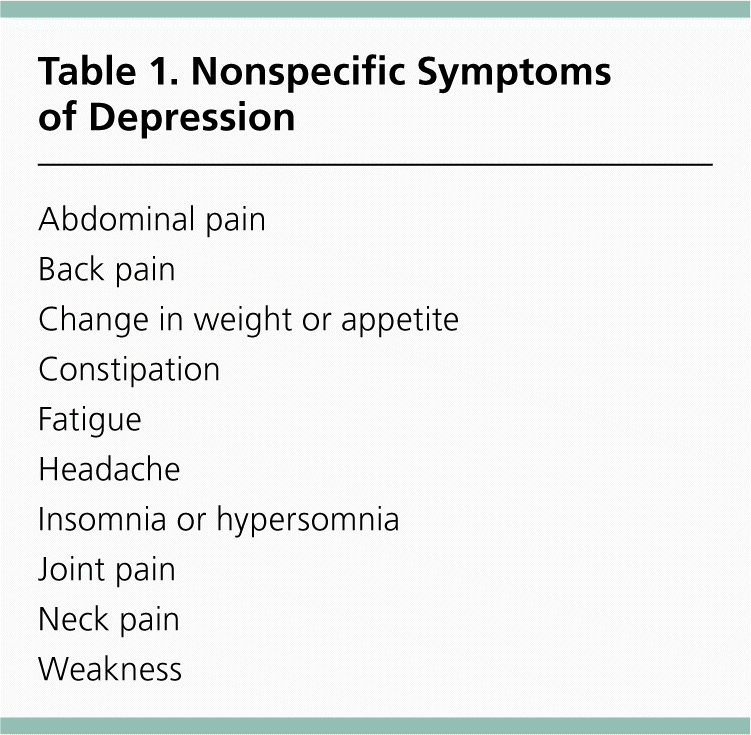
| Abdominal pain |
| Back pain |
| Change in weight or appetite |
| Constipation |
| Fatigue |
| Headache |
| Insomnia or hypersomnia |
| Joint pain |
| Neck pain |
| Weakness |
The underlying cause of depression is likely multifactorial. Risk factors (Table 2) should be considered when evaluating patients with possible depression.
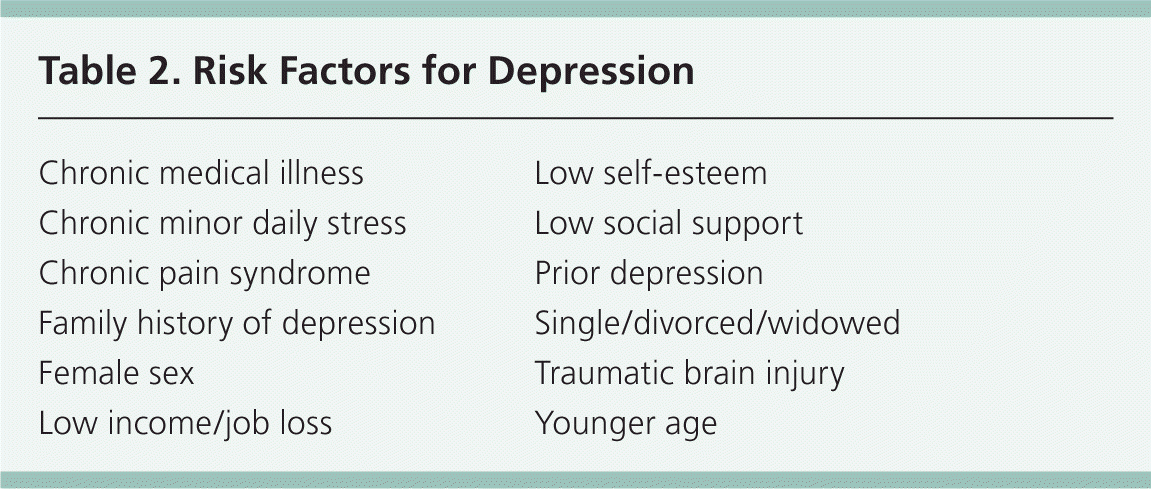
| Chronic medical illness |
| Chronic minor daily stress |
| Chronic pain syndrome |
| Family history of depression |
| Female sex |
| Low income/job loss |
| Low self-esteem |
| Low social support |
| Prior depression |
| Single/divorced/widowed |
| Traumatic brain injury |
| Younger age |
Screening for Depression
A 2005 Cochrane review found that routine depression screening had minimal effect on the management or outcomes of depression after six or 12 months of follow-up.15 However, the U.S. Preventive Services Task Force (USPSTF) has published more recent reviews on depression screening. This article focuses on the recommendations and findings of the USPSTF.
ADULTS
The USPSTF found good evidence that treatment with antidepressants, psychotherapy, or both decreases clinical morbidity and improves outcomes in adults with depression identified through screening in primary care settings. Screening adults for depression is recommended in clinical practices that have systems in place to ensure accurate diagnosis, effective treatment, and follow-up. Screening for depression in clinical practices without these systems is of minimal benefit. Furthermore, the USPSTF found no evidence of harms of screening for depression in adults.16
The USPSTF found insufficient evidence to recommend for or against screening for suicide risk in the general population, compared with screening only those with depression.17
ADOLESCENTS AND CHILDREN
The USPSTF recommends screening adolescents 12 to 18 years of age for depression in clinical practices that have systems (or referral systems) in place to ensure accurate diagnosis, psychotherapy (cognitive behavioral or interpersonal therapy), and follow-up. There is insufficient evidence to balance the benefits and harms of depression screening in children seven to 11 years of age. There is adequate evidence that treatment with selective serotonin reuptake inhibitors, psychotherapy, or both decreases depression symptoms in adolescents. Similar evidence is lacking in children.18
SCREENING INSTRUMENTS
Many instruments have been developed for depression screening. Although the USPSTF found little evidence that one is superior, the most practical tool for the clinical setting should be used.16,18 Positive results on a screening test should trigger full diagnostic interviews that use standard diagnostic criteria from the Diagnostic and Statistical Manual of Mental Disorders, 4th ed. (DSM-IV).
PHQ-2. Ultrashort screening instruments, such as the Patient Health Questionnaire (PHQ)-2 (Table 3) may rule out, but not definitively diagnose, depression.19 However, the PHQ-2, which asks two simple questions about mood and anhedonia, has strengths. It is as effective as longer screening instruments, such as the Beck Depression Inventory or Zung Depression Scale.15,20,21 The PHQ-2 has been found to be up to 97 percent sensitive and 67 percent specific in adults, with a 38 percent positive predictive value and 93 percent negative predictive value.21 It is reported to have a 74 percent sensitivity and 75 percent specificity in adolescents.22

| Over the past two weeks, how often have you been bothered by any of the following problems? | Not at all | Several days | More than one-half the days | Nearly every day |
|---|---|---|---|---|
| Little interest or pleasure in doing things | 0 | 1 | 2 | 3 |
| Feeling down, depressed, or hopeless | 0 | 1 | 2 | 3 |
PHQ-9. The PHQ-9 (Table 4) is one of the most common instruments used for depression screening. Although it can be used on its own as a screening test or to monitor treatment, it is increasingly administered for confirmation of a positive PHQ-2 result. The PHQ-9 is valid, takes two to five minutes to complete, and has demonstrated 61 percent sensitivity and 94 percent specificity for mood disorders in adults, and 89.5 percent sensitivity and 77.5 percent specificity in adolescents.23
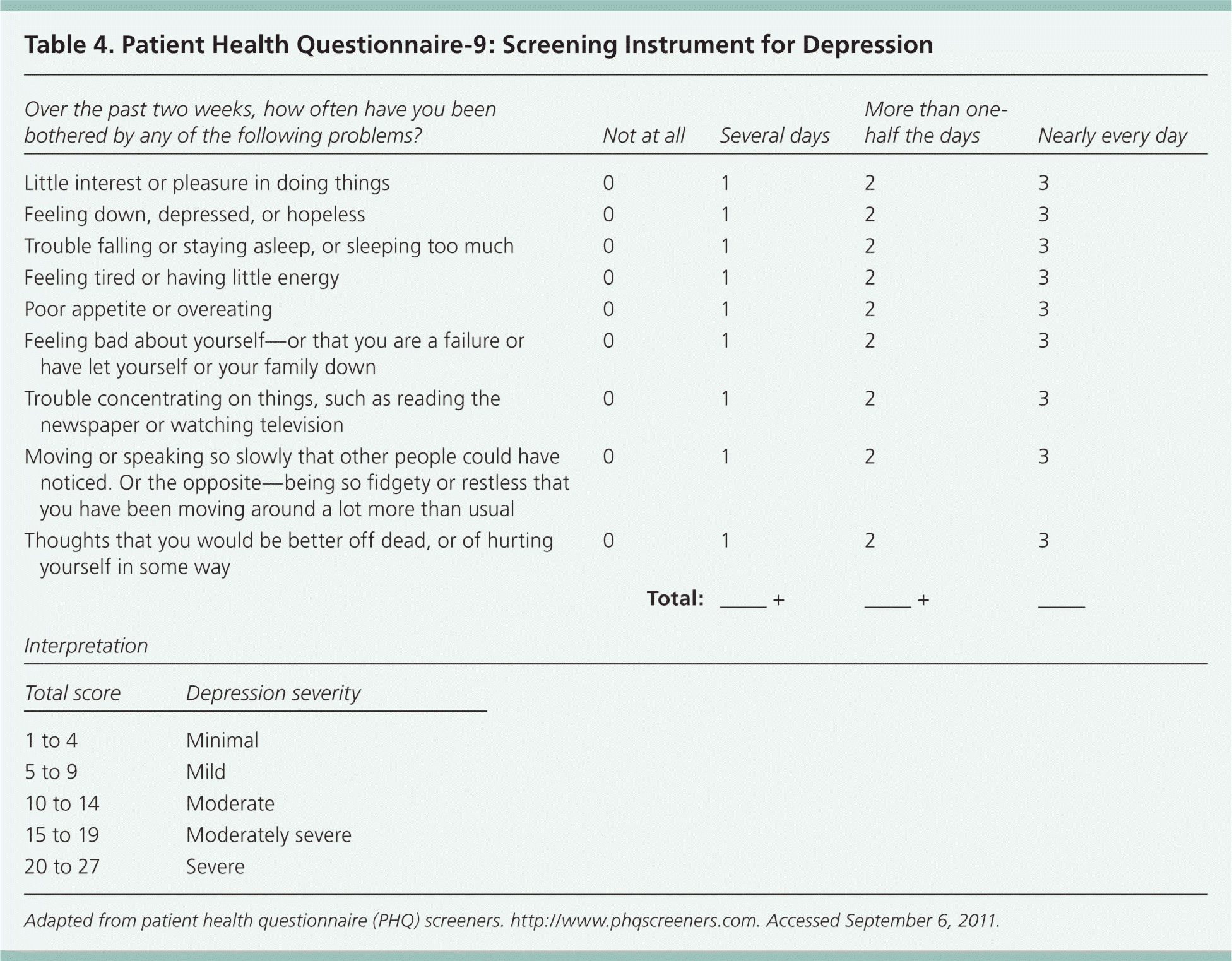
| Over the past two weeks, how often have you been bothered by any of the following problems? | Not at all | Several days | More than one-half the days | Nearly every day | |
|---|---|---|---|---|---|
| Little interest or pleasure in doing things | 0 | 1 | 2 | 3 | |
| Feeling down, depressed, or hopeless | 0 | 1 | 2 | 3 | |
| Trouble falling or staying asleep, or sleeping too much | 0 | 1 | 2 | 3 | |
| Feeling tired or having little energy | 0 | 1 | 2 | 3 | |
| Poor appetite or overeating | 0 | 1 | 2 | 3 | |
| Feeling bad about yourself—or that you are a failure or have let yourself or your family down | 0 | 1 | 2 | 3 | |
| Trouble concentrating on things, such as reading the newspaper or watching television | 0 | 1 | 2 | 3 | |
| Moving or speaking so slowly that other people could have noticed. Or the opposite—being so fidgety or restless that you have been moving around a lot more than usual | 0 | 1 | 2 | 3 | |
| Thoughts that you would be better off dead, or of hurting yourself in some way | 0 | 1 | 2 | 3 | |
| Total: | ____+ | ____+ | ____ | ||
| Interpretation | |||||
| Total score | Depression severity | ||||
| 1 to 4 | Minimal | ||||
| 5 to 9 | Mild | ||||
| 10 to 14 | Moderate | ||||
| 15 to 19 | Moderately severe | ||||
| 20 to 27 | Severe | ||||
Screening Instruments for Older Adults. A systematic review of 18 studies evaluating nine screening instruments in patients older than 65 years demonstrated sensitivities of 74 to 100 percent, and specificities of 53 to 98 percent.24 The PHQ-2 has a sensitivity of 100 percent and specificity of 77 percent in these patients,25 whereas the 30-item and the 15-item Geriatric Depression Scales have a sensitivity of 74 to 100 percent and a specificity of 53 to 98 percent.24 A five-item Geriatric Depression Scale (Table 5) was found to be as effective as the 15-item scale, with 97 percent sensitivity and 85 percent specificity.26 [ corrected]
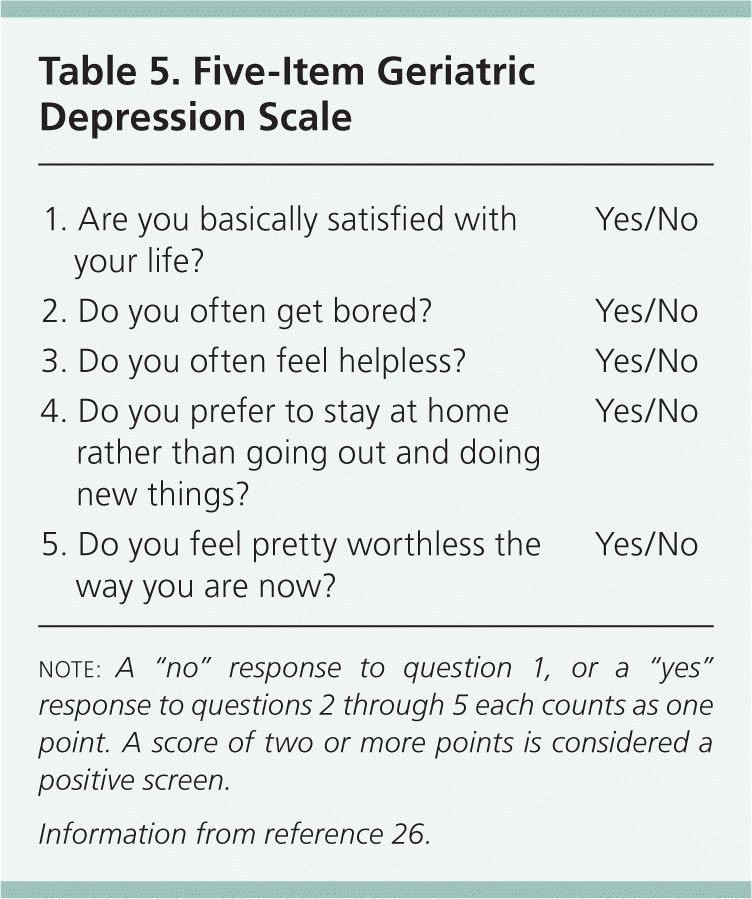
| 1. Are you basically satisfied with your life? | Yes/No |
| 2. Do you often get bored? | Yes/No |
| 3. Do you often feel helpless? | Yes/No |
| 4. Do you prefer to stay at home rather than going out and doing new things? | Yes/No |
| 5. Do you feel pretty worthless the way you are now? | Yes/No |
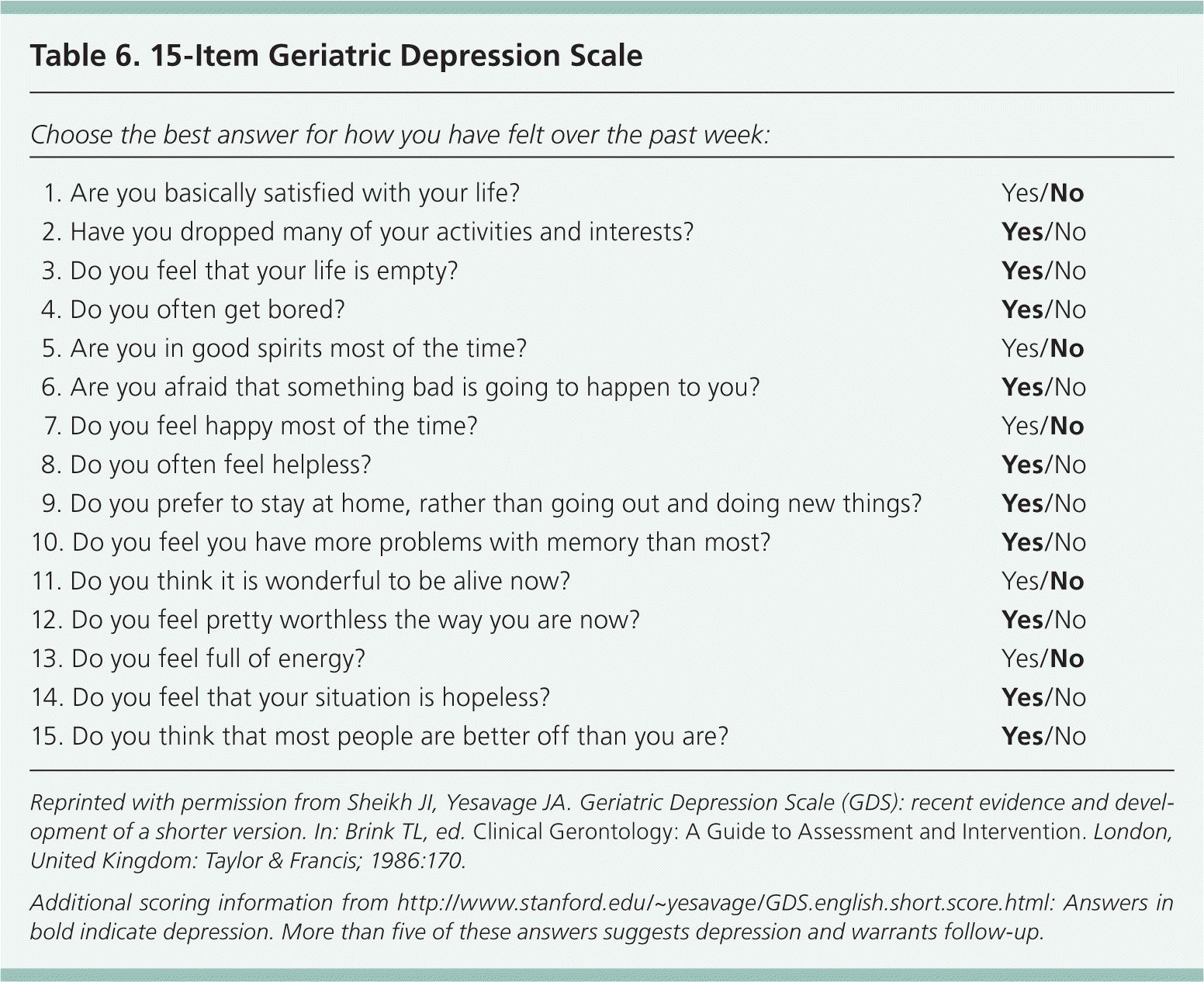
| Choose the best answer for how you have felt over the past week: | |
|---|---|
| 1. Are you basically satisfied with your life? | Yes/No |
| 2. Have you dropped many of your activities and interests? | Yes/No |
| 3. Do you feel that your life is empty? | Yes/No |
| 4. Do you often get bored? | Yes/No |
| 5. Are you in good spirits most of the time? | Yes/No |
| 6. Are you afraid that something bad is going to happen to you? | Yes/No |
| 7. Do you feel happy most of the time? | Yes/No |
| 8. Do you often feel helpless? | Yes/No |
| 9. Do you prefer to stay at home, rather than going out and doing new things? | Yes/No |
| 10. Do you feel you have more problems with memory than most? | Yes/No |
| 11. Do you think it is wonderful to be alive now? | Yes/No |
| 12. Do you feel pretty worthless the way you are now? | Yes/No |
| 13. Do you feel full of energy? | Yes/No |
| 14. Do you feel that your situation is hopeless? | Yes/No |
| 15. Do you think that most people are better off than you are? | Yes/No |
Diagnosis of Depression
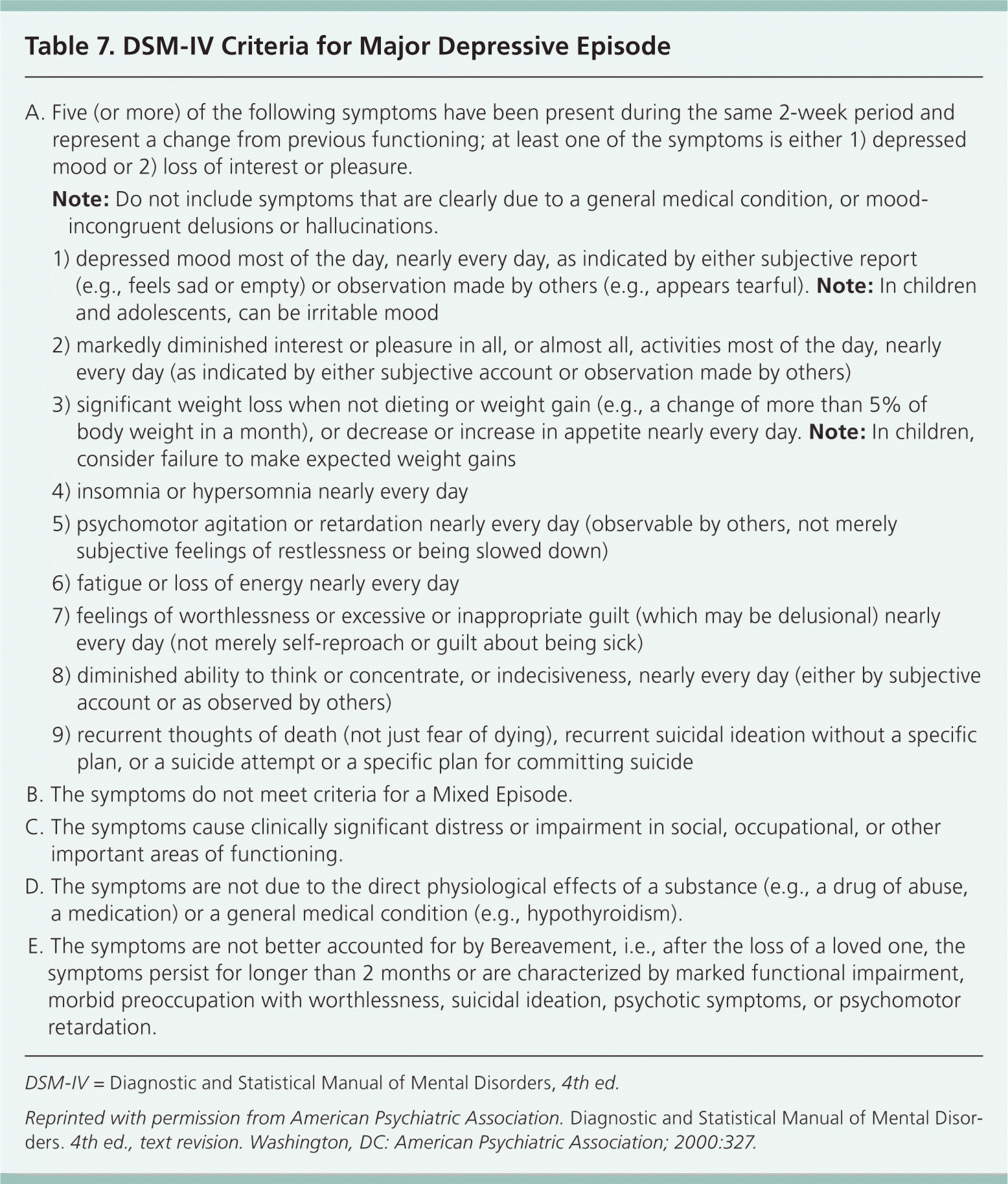
| A. Five (or more) of the following symptoms have been present during the same 2-week period and represent a change from previous functioning; at least one of the symptoms is either 1) depressed mood or 2) loss of interest or pleasure. | |
| Note: Do not include symptoms that are clearly due to a general medical condition, or mood-incongruent delusions or hallucinations. | |
| 1) depressed mood most of the day, nearly every day, as indicated by either subjective report (e.g., feels sad or empty) or observation made by others (e.g., appears tearful). Note: In children and adolescents, can be irritable mood | |
| 2) markedly diminished interest or pleasure in all, or almost all, activities most of the day, nearly every day (as indicated by either subjective account or observation made by others) | |
| 3) significant weight loss when not dieting or weight gain (e.g., a change of more than 5% of body weight in a month), or decrease or increase in appetite nearly every day. Note: In children, consider failure to make expected weight gains | |
| 4) insomnia or hypersomnia nearly every day | |
| 5) psychomotor agitation or retardation nearly every day (observable by others, not merely subjective feelings of restlessness or being slowed down) | |
| 6) fatigue or loss of energy nearly every day | |
| 7) feelings of worthlessness or excessive or inappropriate guilt (which may be delusional) nearly every day (not merely self-reproach or guilt about being sick) | |
| 8) diminished ability to think or concentrate, or indecisiveness, nearly every day (either by subjective account or as observed by others) | |
| 9) recurrent thoughts of death (not just fear of dying), recurrent suicidal ideation without a specific plan, or a suicide attempt or a specific plan for committing suicide | |
| B. The symptoms do not meet criteria for a Mixed Episode. | |
| C. The symptoms cause clinically significant distress or impairment in social, occupational, or other important areas of functioning. | |
| D. The symptoms are not due to the direct physiological effects of a substance (e.g., a drug of abuse, a medication) or a general medical condition (e.g., hypothyroidism). | |
| E. The symptoms are not better accounted for by Bereavement, i.e., after the loss of a loved one, the symptoms persist for longer than 2 months or are characterized by marked functional impairment, morbid preoccupation with worthlessness, suicidal ideation, psychotic symptoms, or psychomotor retardation. | |
Depressive symptoms that do not meet the DSM-IV criteria for depression may be due to other psychological syndromes, such as dysthymic disorder, cyclothymic disorder, substance abuse, bereavement, or bipolar disorder. It is critical to rule out bipolar disorder as a manifestation of the patient's depression. The Mood Disorder Questionnaire is a validated screening tool for bipolar disorder.31
Medical conditions that can mimic depression should also be excluded. Measurement of thyroid-stimulating hormone level should be ordered in patients with signs or symptoms of hypothyroidism.32 Similarly, a complete blood count is needed to rule out anemia. The American Geriatrics Society recommends measurement of thyroid-stimulating hormone, vitamin B12, calcium, and electrolyte levels; liver and kidney function tests; urinalysis; and complete blood count in older adults with symptoms of depression.28
